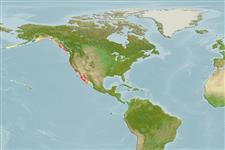Common names from other countries
>
Eupercaria/misc (Various families in series Eupercaria) >
Sciaenidae (Drums or croakers)
Etymology: Atractoscion: Greek, atraktos, arrow + Greek, skion, skiaina = barbel, red mullet (Ref. 45335).
More on author: Ayres.
Environment: milieu / climate zone / depth range / distribution range
Ecología
marino demersal; rango de profundidad 0 - 122 m (Ref. 2850). Subtropical; 65°N - 22°N
Eastern Pacific: Alaska to southern Baja California, Mexico and the Gulf of California.
Tamaño / Peso / Age
Maturity: Lm ? range ? - ? cm
Max length : 166 cm TL macho / no sexado; (Ref. 40637); common length : 100.0 cm TL macho / no sexado; (Ref. 9118); peso máximo publicado: 41.0 kg (Ref. 2850); edad máxima reportada: 20 años (Ref. 56049)
Short description
Claves de identificación | Morfología | Morfometría
Espinas dorsales (total) : 10 - 11; Radios blandos dorsales (total) : 20 - 23; Espinas anales: 2; Radios blandos anales: 8 - 9; Vértebra: 24. Pelvic fins with fleshy appendage at base.
Often in schools over rocky bottom and in kelp beds (Ref. 2850). Also found in the surf zone (Ref. 2850). Young in bays and along sandy beaches (Ref. 2850). Feed on fishes, squids, and crayfish (Ref. 6885). Pelagic spawners (Ref. 56049). Excellent food fish (Ref. 9118).
Pelagic spawner (Ref. 56049).
Eschmeyer, W.N., E.S. Herald and H. Hammann, 1983. A field guide to Pacific coast fishes of North America. Boston (MA, USA): Houghton Mifflin Company. xii+336 p. (Ref. 2850)
IUCN Red List Status (Ref. 130435)
CITES (Ref. 128078)
Not Evaluated
Threat to humans
Harmless
Human uses
Pesquerías: escaso valor comercial; pesca deportiva: si
Herramientas
Special reports
Download XML
Fuentes de Internet
Estimates based on models
Preferred temperature (Ref.
115969): 9 - 22.9, mean 12.8 (based on 76 cells).
Phylogenetic diversity index (Ref.
82804): PD
50 = 0.5312 [Uniqueness, from 0.5 = low to 2.0 = high].
Bayesian length-weight: a=0.00794 (0.00404 - 0.01563), b=3.07 (2.91 - 3.23), in cm Total Length, based on LWR estimates for this species & (Sub)family-body (Ref.
93245).
Nivel trófico (Ref.
69278): 4.3 ±0.70 se; based on food items.
Resiliencia (Ref.
120179): Bajo, población duplicada en un tiempo mínimo de 4.5-14 años (K=0.13; tm=4; tmax=20).
Fishing Vulnerability (Ref.
59153): High to very high vulnerability (70 of 100).
Climate Vulnerability (Ref.
125649): Moderate to high vulnerability (48 of 100).
